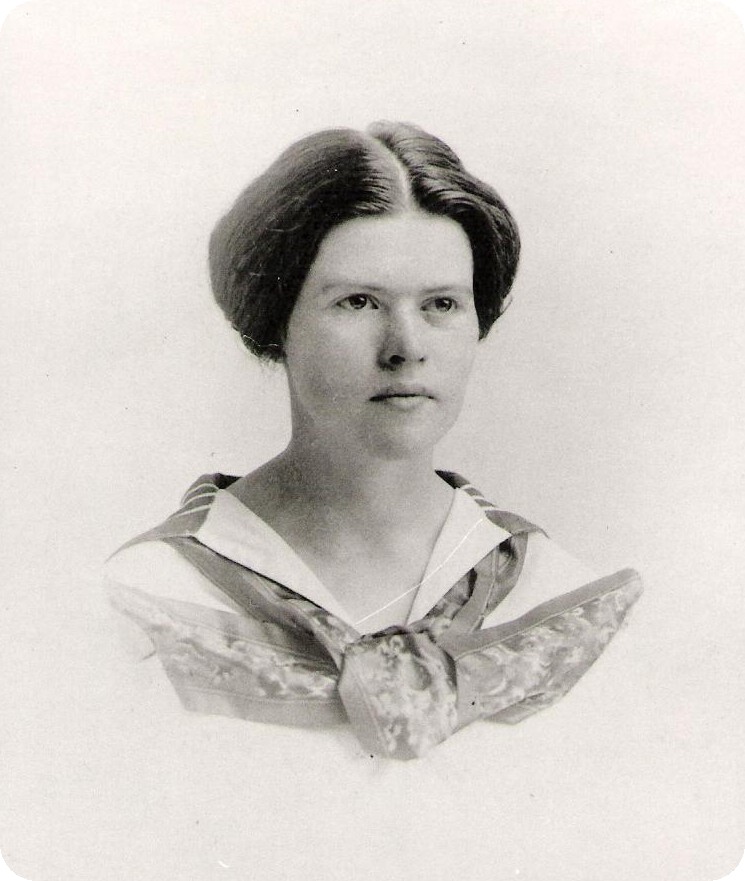

|
TEACHERS PHOTO GALLERY
|

Agnes Leahy -1913
|
Miss Leahy,
one of twelve siblings, was born and raised on the family farm in Sugar Ridge not far from the Campbellville schoolhouse. Agnes was twenty six years old and lived at home when teaching there. Two years later she married Lawrence E. Cullen and moved to New Albany. Many of her pupils were distant relatives.
click link below to see her 1913 school report
|

Genevieve Marshall
1923 - 1924
|
Miss Marshall,
Any information available about Miss Marshall
would be most appreciated. Info such as, where
she was born, when & who she married, any
personal type things like shown of the above teacher.
Email to: campbell9695@sbcglobal.net
|
|
1913 1st - 7th grade
|
1914 1st - 8th grade
|
1915 2nd - 8th grade
|
1916 1st - 8th grade
|
1917 1st - 8th grade
|
|
Miss Agnes Leahy
|
Miss Mary McIntire
|
Mr. Claude J Shaffer
|
Mr. C. J. Shaffer
|
Mr. C. J. Shaffer
|
|
Cletus Kester
Regis Kelly
Valeria Bahl
Albert Kester
Francis Kelly
Florence Kelly
Alice Kelly
Raymond Kelly
George Bahl
Jerome Kelly
Erma Kester
Rebecca Keeny
Grace Bahl
Julia Kelly
James Kelly
|
Jerome Kelly
Raymond Kelly
Albert Kester
Cletis Kester
Francis Kelly
Regis Kelly
Willie Kelly
Rebecca Kenney
Julia Kenney
Florence Kelly
Alice Kelly
Erma Kester
|
Grace Bahl
George Bahl
Earma Kester
Florence Kelly
Valeria Bahl
Alice Kelly
Raymond Kelly
Francis Kelly
Albert Kester
Vincent Bahl
Cletuis Kester
Regis Kelly
Willie Kelly
|
Erma Kester
Florence Kelly
Alice Kelly
Valeria Bahl
Genevieve Frawley
Mary Kelly
Albert Kester
Cletius Kester
Vincent Bahl
Regis Kelly
Willie Kelly
Raymond Kelly
Francis Kelly
Ivan Frawley
|
Alice Kelly
Valeria Bahl
Raymond Kelly
Albert Kester
Vincent Bahl
Willie Kelly
Cletius Kester
Ivan Frawley
Genevieve Frawley
Ethel Wank
|
|
1918 2nd - 8th grade
|
1919 1st - 7th grade
|
1922
|
1923
|
1924
|
|
Miss Marcela G. Scanlin
|
Miss Julia Kelly
|
Miss Myrtle Hansknecht
|
Miss Genevieve Marshall
|
Miss Genevieve Marshall
|
|
Raymond Kelly
Albert Kester
William Kelly
Cletius Kester
Vincent Bahl
Ethel Wank
|
Albert Kester
Raymond Kelly
Cletius Kester
Vincent Bahl
Willie Kelly
Lewis Wank
Ethel Wank
Margaret Gabriel
Jeanatta Gabriel
|
Ethel Wank
Lewis Wank
Edith Shaffer
Winifred Keeney
Ilene Keeney
George Gabor
Gerald Shaffer
|
Ethel Wank
Winifred Keeney
Ilene Keeney
Edith Shaffer
Hazel Rinehold
Edna Shaffer
Anna Rinebold
Neta Rinebold
Lewis Wank
George Gabor
Gerald Shaffer
Philip Shaffer
Charles Hunsinger
William Brown
|
Ethel Wank
Hazel Rinebold
Anna Rinebold
Pauline Shaffer
Edith Shaffer
Edna Shaffer
Neta Rinebold
Ilene Keeney
Winifred Keeney
Marion Driscoll
Lewis Wank
Gerald Shaffer
Philip Shaffer
George Gabor
Carl Driscoll
|
|
The Fifth grade reading class was: Maynard Warburton, Josephine Kelley, Ettie Faucett (Fawcett) and Sumner Warburton.
The Fourth grade reading class was: Agnes Kelley, Freddie Clark, Newman Warburton, Katie Warburton, Minnie Mullenix and Joseph Bedford.
The First grade reading class was: Amos Wank and Joseph Kelley. Students that attended class every day during the last six months were Ettie Faucett, Amos Wank and Newman Warburton.
Note: Bob Sweeney submitted this interesting item. Student Agnes Kelley remarked years later that she would walk to school barefoot in march with snow still on the ground. She remembered coming home to eat a big pot of potatoes that had been cooking all day long.
|